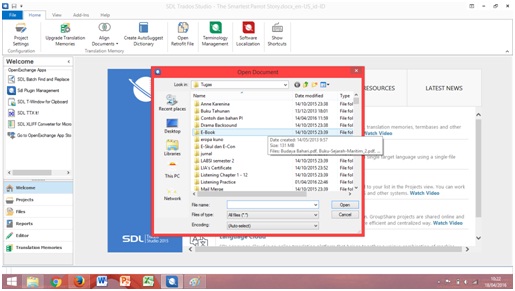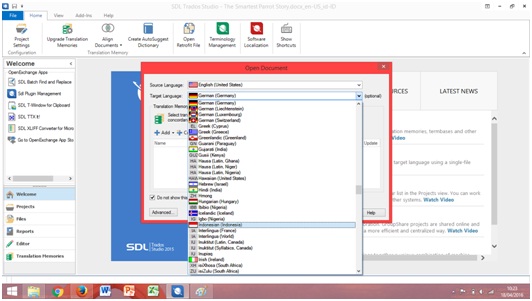Trados (CAT tools)
What is Trados?
SDL Trados is a computer-assisted translation software suite, originally developed by the German company Trados GmbH and currently available from SDL plc, a provider of customer experience cloud solutions. It is considered the market-leader in providing translation software solutions across the entire translation supply chain, including freelance translators, language service providers, corporate language departments and academic institutions.
Trados GmbH was founded as a language service provider (LSP) in 1984 by Jochen Hummel and Iko Knyphausen in Stuttgart, Germany. The company began developing translation software in the late 1980s, and released the first Windows versions of two of the suite’s major components in the early 1990s – MultiTerm in 1992, and Translator’s Workbench in 1994. In 1997, the company received a major boost when Microsoft decided to use Trados for its internal localization needs. By the end of the 1990s, it had become the clear market leader in desktop translation memory software.
Features


SDL Trados Studio is delivered with several tools and applications. These are:
- SDL Trados Studio
The main application providing a complete environment to edit or review translations, manage translation projects, organize terminology, and connect to machine translation.
- SDL MultiTerm
A terminology management tool that is integrated with SDL Trados Studio for adding, editing and managing terms.
- SDL Language Cloud
Secure access to machine translation engines that can be accessed directly from within SDL Trados Studio.
- SDL OpenExchange
SDL Trados Studio includes several applications for the SDL OpenExchange – an online marketplace which offers apps to help with a range of translation processes, for example further file format support and task automation.
Handling of translation memories and glossaries
The translation memory (TM) format of Trados is SDLTM, which consists in a particular SQLite database.
When creating a new (file-based) translation memory, SDL Trados Studio creates a database file in which all translation units are stored. The translation memory also stores structural and context information to link all the different segments and their position in a document. This allows the tool to select the most relevant translation memory segment.
Main translation memory database file: .sdltm
In previous version of Trados a neural network of files that enable fuzzy search capability was also created. A new translation memory consists of five new files:
Main translation memory database file: .tmw
Neural network files: .mdf, *.mtf, *.mwf, *.iix
When copying a translation memory, you must copy all five translation memory files. Otherwise, Translator’s Workbench displays an error message when opening the copied translation memory.Trados can also work with server-based translation memories. Glossaries are handled by the MultiTerm application. Glossaries can be bilingual or multi-lingual.
The great news is that SDL Trados Studio 2015 will make your life a whole lot easier. Discover new ways to increase your productivity, ensure the highest levels of translation quality and personalize your Studio to suit you.
- Easier to use
Traditional menus are replaced with a brand new ribbon navigation that feels quicker and more intuitive than any previous versionUsers who are not familiar with SDL Trados Studio can immediately take advantage of the ‘getting started’ resources, which can be found on the new welcome screen. Find easy access to video tutorials and help articles to get you up and running as quickly as possible.
- Faster than ever
Trados can fill the large projects with multiple files. Teams that share linguistic assets will be happy to know that SDL GroupShare delivers a much faster server experience. Whether you’re sharing terminology, translation memories or entire projects, the user experience has been significantly improved.
- More productivity tools
Use any file format supported by SDL Trados Studio and all alignments can be edited to improve quality. The new AutoSuggest feature provides suggestions from more sources including whole phrases coming from machine translation services as well as concordance and fuzzy match results coming directly from your translation memory. Source content can now be edited directly from the translation environment.
- Enabling enhanced quality
Automatically update your bilingual file from a reviewed target file and immediately import the latest changes to your TM to streamline the review process. Accept and reject any changes clearly marked using Track Changes for improved quality, while keeping your TM up to date. A spellchecker certainly helps, but it’s not foolproof and mistakes can slip through the cracks.
- Support the latest file types
Continue to accept any project with our latest additions and updates of file formats, including:
- New, faster XLIFF filter which now supports alternate translations
- New, faster HTML filter with HTML5 and SGML support
- Redeveloped, faster TTX filter
- Enhanced XML filter with an embedded content filter setting, supporting open W3C standards such as ITS 2.0
- New, improved PDF filter with built-in OCR functionality enabling the translation of scanned documents
- New, robust Microsoft Word filter for better handling of Word files
- New bilingual Microsoft Excel file filter
- Improved collaboration capabilities
SDL Trados Studio 2015 fully leverages the entire range of capabilities available with SDL Studio GroupShare where translation projects can be shared for streamlined management of project assets
Advantages :
- Generally, it is useful for specialized texts (medical, technical, legal) if many sentences are repeated throughout the text and only a few words change said sentence, then it is useful to keep consistency.
- You never translate twice the same sentence
- Trados allow you to translate files in InDesgin, X-Press, HTML,etc
- Have a lot of plug-in who allow you to make reliable quality checker.
- Trados has storage to save the result of translation, so translator does not need to translate again. Therefore, trados is very useful for translators.
- Supported source document formats
SDL Trados Studio 2015 supports over 70 different file types, including: various markup and tagged formats such as SGML, XML, HTML, XLIFF, SDLXLIFF (Studio’s native format for translation), OpenDocument files; straight text files; source code files, such as Java and Microsoft .NET; Microsoft Word, Excel, Bilingual Excel and PowerPoint; and some Adobe file formats, such as PDF, scanned PDF (OCR is included) FrameMaker, InDesign, and InCopy.
- Handling of translation memories and glossaries
The translation memory (TM) format of Trados is SDLTM, which consists in a particular SQLite database.When creating a new (file-based) translation memory, SDL Trados Studio creates a database file in which all translation units are stored. The translation memory also stores structural and context information to link all the different segments and their position in a document. This allows the tool to select the most relevant translation memory segment.
- Main translation memory database file: .sdltm
translation memory consists of five new files:
Main translation memory database file: .tmw
Neural network files: .mdf, *.mtf, *.mwf, *.iix
- Glossaries are handled by the MultiTerm application. Glossaries can be bilingual or multi-lingual.
- Integration of Machine Translation and Post-Editing
SDL Trados Studio 2015 has integrated machine translation and postediting into its translation workflow.
Disadvantages
- In general text or literary translations, it is not help.
- The cost is still expensive
- The application need a huge space to be installed.
HOW TO USE TRADOS





Class : 4SA04
Agatha O.
Asti febriani
Lilik mudrika F
Marsa tsuraya
Robi Budiman
Reference :
https://arabtranslatorsgroup.wordpress.com/2013/11/23/cat-tools-history-advantages-disadvantages/
http://www.computing.dcu.ie/~kkeogh/review_by_trados.pdf
https://en.wikipedia.org/wiki/SDL_Trados